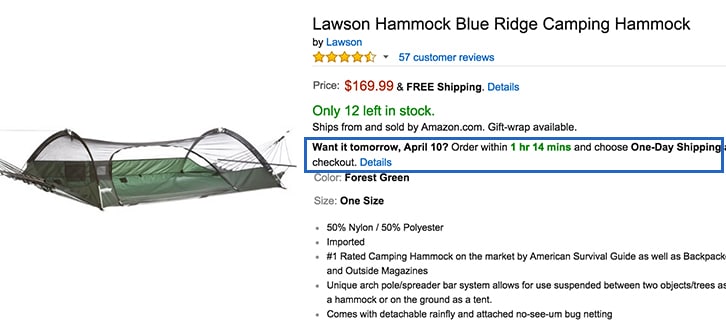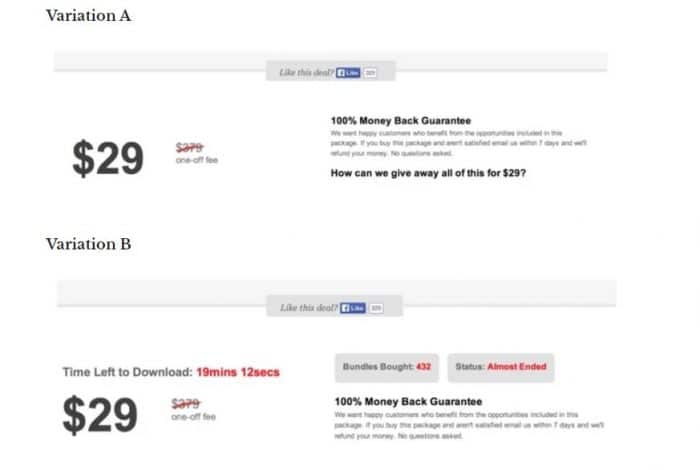How Your Business Can Use Scarcity Marketing To Increase Sales

We all want what we can’t have.
And we flaunt when we have something others don’t.
That’s why zealous Apple fans camp overnight at Apple stores around the world before major iPhone launches.
It’s also why certain fashion brands charge tens of thousands of dollars for women’s purses that should cost significantly less.
The “fear of missing out” (FOMO) causes consumers to behave in irrational, unpredictable ways.
And it doesn’t hurt that scarcity typically creates lots of buzz around a product.
In today’s media-intensive culture, buzz can create virality and give your product or service a huge marketing boost.
While economics may lay down the foundational laws of supply and demand, marketing can use scarcity to manipulate the variables and win big.
Smart marketers and business owners control both variables. That gives them an unfair advantage of influence over pricing and profit margins.
Here’s how you can level the playing field and get the same advantage for your business, using scarcity marketing techniques.
What is scarcity marketing?
Scarcity marketing is a marketing technique based on the principle that people want what is difficult to get.
Scarcity is a core principle of marketing psychology and one of Dr. Robert B. Cialdini’s “6 Principles of Influence”. Read about some of the other principles in our prior articles on why your business can die without social proof and how you can use commitment and consistency principles to increase sales.

www.readinggraphics.com
The psychology of scarcity
The psychology of scarcity was famously tested in 1975. Researchers Worchel, Lee, and Adewole wanted to determine desire based on scarcity.
Their experiment was simple: They placed two replica cookie jars side by side. They filled one jar with many cookies and the other with only two.
The question: Which cookie would people value more?
Ultimately, the cookie jar with only two cookies was rated as more desirable simply due to their scarcity.
Examples of businesses that excel with scarcity marketing
Kylie Jenner is the queen of scarcity marketing with her business, Kylie Cosmetics ($900 million).
As we previously mentioned,
Consider Kylie Jenner, child celebrity turned billionaire.
Kylie has a makeup line that promotes exclusivity. She manufactures a limited supply of her makeup collections – to her benefit. The concept of, “limited offers” serves as an exclusive one time only feeling that fans use to think of “now or never”.
A simple eBay search on Kylie Jenner reveals products being sold for over roughly three times the original selling price.
Exclusivity is working for Kylie.
Kylie fuels demand with exclusive Instagram promotions, limited and holiday edition products, and pop-up stores around the United States.
It doesn’t take an individual influencer like Kylie Jenner to fuel demand. Even big brands can generate excitement around scarcity.
Consider the popular coffee chain Starbucks.
Starbucks has positioned itself as the preferred coffee shop. But it wasn’t the coffee that triggered serious FOMO (fear of missing out) in 2017.
Let’s get reacquainted with their mythical drink that caused the world to flock to every Starbucks in a 5-mile radius.
Introduced on Instagram, this colorful drink was only available for 7 days and quickly became viral.
With over 150,000 user-generated shares on Instagram alone (ie. consumers photos of the product), the Unicorn Frappuccino was all the internet was talking about.
In fact, there were more people talking about how much they didn’t like the taste of the product, than those who liked it.
At the end of the day, it didn’t matter if the drink was loved or hated — it was being talked about. And people wanted to taste it to see if they loved or hated it.
So how did Starbucks generate so much noise?
According to Marketing and Growth Hacking, there were 4 simple steps.
- Flash Marketing: Limited Products Become More Valuable
- FOMO: Everyone Wants A Frappuccino, But Not Everyone Gets A Frappuccino
- The Psychology of Color: First It’s Purple, Then It’s Pink
- Frequency Illusion: Unicorns Here, There, and Everywhere
How your business can leverage scarcity marketing to increase sales
Here are 5 things you can do to leverage scarcity marketing:
1. Start by strengthening your brand identity
Before we jump into ways to incorporate scarcity tactics into your marketing, you first must make sure you have a strong brand identity.
Your brand identity is everything visual about your brand and includes your company logo, website design, and the products your company sells.
Before you can create FOMO and buzz around your products, be sure the products are compelling.

We just emailed the info to you.
Consumers understand that higher quality products take more time and money to produce. As a result, the higher the price, the fewer of those products are sold.
This is true with small-batched alcohol, limited-print pieces of art, and high-end vehicles.
But brands with poor brand identities and badly designed products rarely succeed with scarcity marketing. The brands and products have to be compelling too.
Some brands focus on being accessible and affordable, but a brand focusing on scarcity is more concerned with exclusivity.

Tesla’s Model 3, when launched, was scarce and over 500,000 people put down a deposit and waited a year.
2. Create a niche group of customers
Scarcity marketing thrives on a members-only attitude.
These days most families have an Xbox, but few have the Xbox Elite edition.
All Tesla owners drive a Tesla, but few drive the Performance versions of their Model 3, Model S, or Model X.
The days of iPhones being only for the elite are gone, but only a small number of people have the highly coveted Red iPhone XR.
This is a form of exclusivity scarcity, which states that the item may not be short on supply, but instead only an elite few are able to acquire it.
We talk about this in our guide on starting a business:
Have early customers post their rave reviews everywhere that matters – your website, your social media platforms, and anywhere else where other potential customers will see them.
Reward those early fans with special treats – access to special events, promotions, or discounts are always great, but even a handwritten thank you card can go a long way in turning a fan into a lifelong follower.
Waitlists are also an excellent way to garner a niche crowd.
In their early days, Pinterest had a “by invitation only” membership. This served as a great tool to get others talking about the newest social platform in town.

3. Artificially reduce the availability of your product or service
Launching a limited-supply product is an effective way to create buzz.
It may seem counterproductive to limit supply, but the buzz created by a lack of supply can significantly boost long-term sales at the expense of lower short-term sales.
4. Use these scarcity tactics to boost conversions
Time-sensitive deals
This tactic works when a customer feels pressure to buy before the deal ends.
Online retail super-star Zulily is doing time-sensitive deals right. Their slogan? A New Store Every Day. Most of Zulily’s sales events last a mere 72 hours. Once a sale is done, Zulily moves on to the next exciting product.
Only X left!
Remember that cookie jar experiment we mentioned above? Booking.com sure does. In fact, they made a business out of it.
Booking.com bets money on the fact that it’s very likely most people have tried booking hotel rooms only to find no vacancy.
By highlighting how many rooms are left, Booking urges people to purchase right away.
Letting your clients and prospects know how limited your stock is can be enough to push them over the purchasing fence.
Quick shipping messages
One tactic used by market leader Amazon involves shipping messages. By alerting the customer about shipping availability if ordered right away, Amazon guides the consumer to buy immediately (or risk not being able to get it if the stock is depleted).
Countdown timers
When you have items for sale, adding a countdown timer can be more effective than simply an end of the sale date.
Marcus Taylor launched an A/B test on advertisements without a countdown timer (A) and with one (B) and the results were staggering.
This is one of the most impactful A/B tests I’ve ever run. The conversion rate of Variation B was almost 3 times that of variation A.
Here’s what happened to our conversion rate as we gradually rolled out Variation B to all users. It went from ~3.5% to ~10%.
Focus on rare and hard to find items
Lego has made a massive comeback.
A popular toy for decades, Lego was able to transition from near bankruptcy in 2003 to uber-successful today.
How did they do it?
Today, Lego uses scarcity as one of their most lucrative marketing tactics. Lego produces high-end, limited-edition sets for expert builders which they label “hard to find”. These sets range in price and are retired once they sell out. Post-retirement sets can sell for up to 5x the retail price.
By creating a sense of urgency to purchase these hard to find sets at retail price, Lego has a sizable following.
Conclusion
Scarcity marketing works when it’s genuine. Do not just say you are the most exclusive. Be the most exclusive.
When a prospective customer realizes that you are not just playing hard to get, but instead your products or services are hard to get (with good reason) – they will buy-in for life.
Design Done Better
The easiest way to get affordable, high-quality custom logos, print design, web design and naming for your business.
Learn How to Grow Your Business With Beautiful Design










